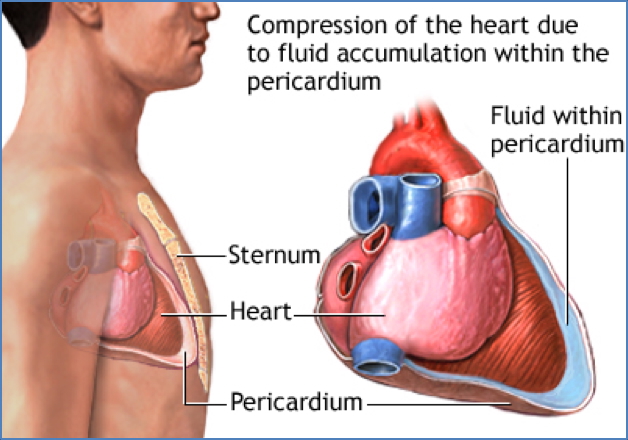Table of Contents
Overview – Cardiac Tamponade
Cardiac tamponade is a life-threatening condition caused by fluid accumulation within the pericardial sac that restricts cardiac filling and reduces cardiac output. It represents a major complication of pericardial effusion and requires urgent diagnosis and intervention. As a clinical emergency, recognising key signs such as hypotension, elevated jugular venous pressure, and muffled heart sounds is vital for prompt treatment.
Definition
Acute compression of the heart due to increased intrapericardial pressure from fluid accumulation, impairing venous return and ventricular filling.
Aetiology
Cardiac tamponade typically arises from severe or rapidly accumulating pericardial effusion due to:
- Trauma (e.g. penetrating chest injury)
- Post-myocardial infarction (free wall rupture)
- Malignancy
- Pericarditis (especially haemorrhagic or purulent forms)
- Aortic dissection
- Anticoagulation complications
- Post-surgical complications
Pathophysiology
- ↑ Intrapericardial pressure → ↓ Venous return to the heart
- ↓ Ventricular filling during diastole → ↓ Stroke volume → ↓ Cardiac output
- → Systemic venous congestion and shock

Clinical Features
Symptoms
- Dyspnoea
- Tachypnoea
- Fatigue
- Syncope or pre-syncope
- Signs of shock (cold peripheries, altered mental status)
Signs
- Beck’s Triad:
- Hypotension
- Elevated JVP
- Muffled heart sounds
- Pulsus paradoxus: Exaggerated ↓ SBP >10 mmHg during inspiration
- Raised JVP with prominent x descent and absent y descent
- Tachycardia
- Hepatic congestion
Investigations
- 12-lead ECG:
- Low voltage QRS
- Electrical alternans (alternating QRS amplitude) — pathognomonic
- Echocardiography:
- Pericardial fluid
- Diastolic collapse of right atrium or right ventricle
- Cardiac catheterisation:
- Equalisation of diastolic pressures in all chambers
- RA/RV/LA/LV pressures elevated and nearly identical
Management
- Emergency pericardiocentesis (ECG- or ECHO-guided) — therapeutic and diagnostic
- Pericardiotomy if recurrent or loculated effusions
- Avoid diuretics and vasodilators — can worsen hypotension by reducing preload
- IV fluids may temporarily support preload and cardiac output
- Identify and treat the underlying cause (e.g. malignancy, infection, trauma)
Complications
- Cardiogenic shock
- Multi-organ failure
- Death if not treated urgently
Summary – Cardiac Tamponade
Cardiac tamponade is an acute emergency due to fluid-induced pressure around the heart that impairs cardiac filling. Urgent diagnosis and pericardiocentesis are essential to restore haemodynamics. For a broader context, see our Cardiovascular Overview page.